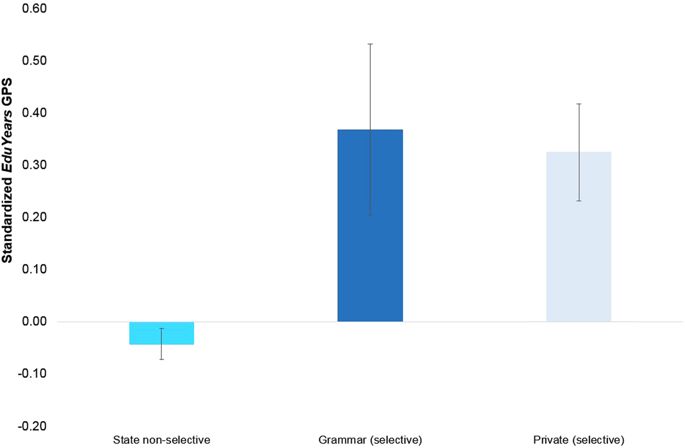npj Science of Learning ( IF 4.2 ) Pub Date : 2018-03-23 , DOI: 10.1038/s41539-018-0019-8 Emily Smith-Woolley 1 , Jean-Baptiste Pingault 1, 2 , Saskia Selzam 1 , Kaili Rimfeld 1 , Eva Krapohl 1 , Sophie von Stumm 3 , Kathryn Asbury 4 , Philip S Dale 5 , Toby Young 6 , Rebecca Allen 7 , Yulia Kovas 8, 9 , Robert Plomin 1

|
On average, students attending selective schools outperform their non-selective counterparts in national exams. These differences are often attributed to value added by the school, as well as factors schools use to select pupils, including ability, achievement and, in cases where schools charge tuition fees or are located in affluent areas, socioeconomic status. However, the possible role of DNA differences between students of different schools types has not yet been considered. We used a UK-representative sample of 4814 genotyped students to investigate exam performance at age 16 and genetic differences between students in three school types: state-funded, non-selective schools (‘non-selective’), state-funded, selective schools (‘grammar’) and private schools, which are selective (‘private’). We created a genome-wide polygenic score (GPS) derived from a genome-wide association study of years of education (EduYears). We found substantial mean genetic differences between students of different school types: students in non-selective schools had lower EduYears GPS compared to those in grammar (d = 0.41) and private schools (d = 0.37). Three times as many students in the top EduYears GPS decile went to a selective school compared to the bottom decile. These results were mirrored in the exam differences between school types. However, once we controlled for factors involved in pupil selection, there were no significant genetic differences between school types, and the variance in exam scores at age 16 explained by school type dropped from 7% to <1%. These results show that genetic and exam differences between school types are primarily due to the heritable characteristics involved in pupil admission.
中文翻译:

精英学校和非精英学校学生考试成绩的差异反映了他们之间的基因差异
平均而言,精英学校的学生在全国考试中的表现优于非精英学校的学生。这些差异通常归因于学校的附加值,以及学校用来选择学生的因素,包括能力、成绩,以及社会经济地位(如果学校收取学费或位于富裕地区)。然而,不同学校类型学生之间 DNA 差异的可能作用尚未被考虑。我们使用了英国 4814 名基因型学生的代表性样本来调查 16 岁时的考试表现以及三种学校类型学生之间的基因差异:国家资助的非选择性学校(“非选择性”)、国家资助的精英学校(“语法”)和选择性的私立学校(“私立”)。我们根据受教育年限的全基因组关联研究 ( EduYears ) 创建了全基因组多基因评分 (GPS)。我们发现不同学校类型的学生之间存在显着的平均遗传差异:与文法学校 ( d = 0.41) 和私立学校 ( d = 0.37)的学生相比,非精英学校学生的EduYears GPS 较低。EduYears GPS 排名前十分位的学生进入精英学校的人数是排名后十分位的学生的三倍。这些结果反映在学校类型之间的考试差异中。然而,一旦我们控制了涉及学生选择的因素,学校类型之间就不存在显着的遗传差异,并且由学校类型解释的 16 岁时考试成绩的差异从 7% 下降到 <1%。这些结果表明,学校类型之间的遗传和考试差异主要是由于学生入学时涉及的遗传特征造成的。



























 京公网安备 11010802027423号
京公网安备 11010802027423号